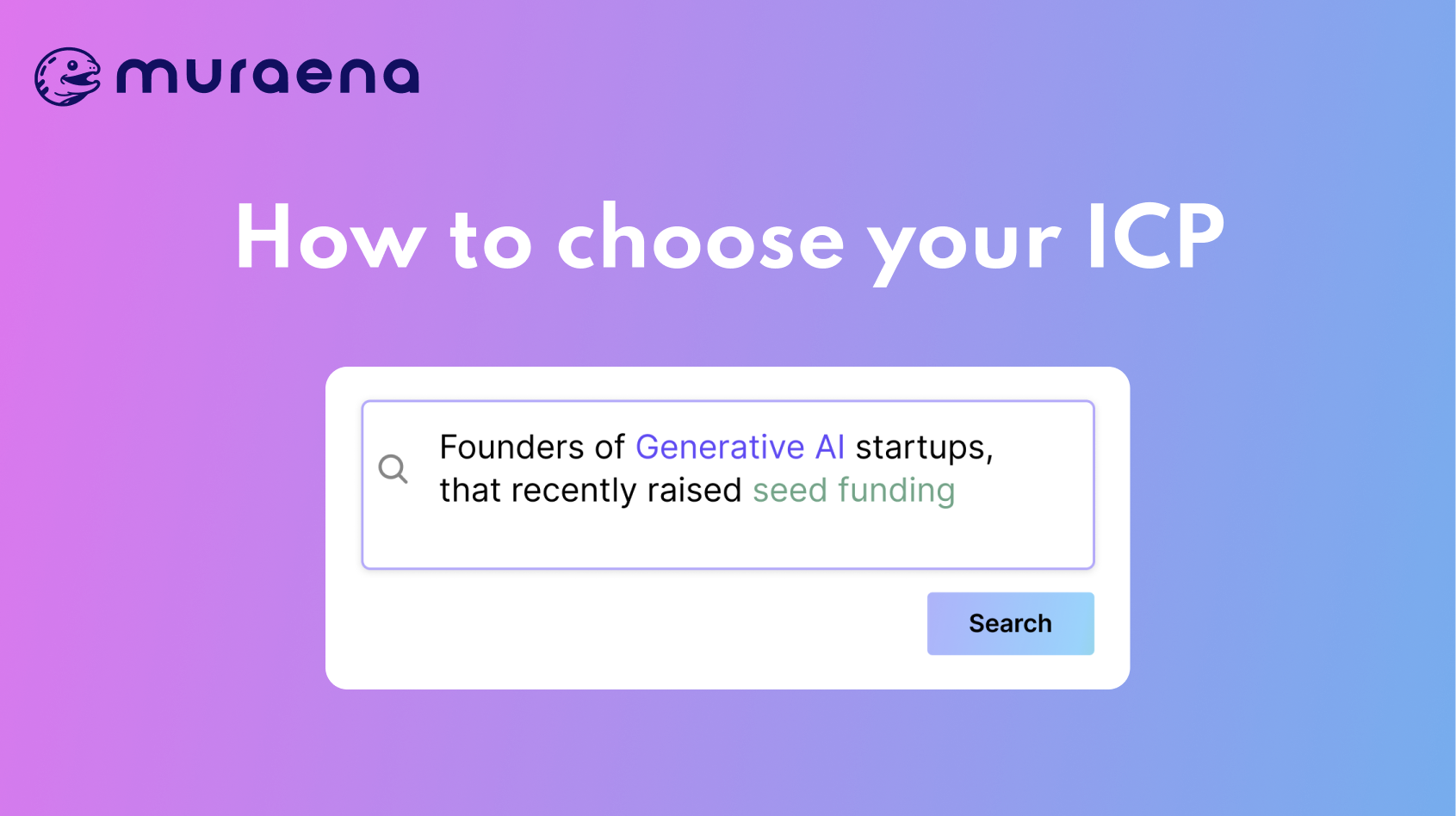How to create your Ideal Customer Profile (ICP) and what to do with it?

Creating an Ideal Customer Profile (ICP) is a crucial step for your B2B sales and marketing strategies. ICP helps you identify and target the right customers, ensuring that your efforts are focused on those who are most likely to benefit from your products or services. This article will guide you through the process of creating an effective ICP and advise on the next steps after you do that taking Muraena.ai as an example.
What is ICP?
An Ideal Customer Profile is a detailed description of a type of company or people that would benefit most from your product or service. It includes demographic, firmographic, technographic, and behavioral data to help businesses identify and target high-potential customers. The concept of ICP emerged from the practice of customer segmentation and was popularized in the early 2000s by marketers and sales strategists looking to refine their targeting strategies.
Understanding the Importance of ICP
Having an ICP is important because it:
- Targets the right customers: Ensures your sales and marketing efforts are focused on high-potential leads.
- Improves lead generation: Increases the quality of leads, resulting in higher conversion rates and better customer acquisition.
Steps to Create an Ideal Customer Profile
1. Define Your Best Customers
Start by analyzing your current customer base. Look at your most successful and satisfied customers and identify common traits. This will help you understand what makes them ideal for your business.
2. Gather Key Data Points
Once you analyzed the best customers, gather some key data points on them:
- Demographic Data: Industry, company size, location.
- Firmographic Data: Revenue, number of employees.
- Technographic Data: Technology stack used.
- Behavioral Data: Buying patterns, buyers intent, engagement level.
3. Use Surveys and Interviews
Engage with your current customers through surveys and interviews. This will provide deeper insights into their needs and challenges. Additionally, talk to your sales and customer support teams to gather their perspectives.
4. Identify Pain Points and Needs
Understand the challenges your customers face and how your product or service solves these issues. This step is crucial in defining how you can provide value to your ideal customers.
Examples of ICP
Creating an Ideal Customer Profile can vary significantly depending on the industry and business model. Here are three examples of how an ICP might look for different types of companies:
- SaaS Company: CTO or Head of Development at a technology startup or small to medium-sized enterprise (SME) in North America or Europe, with 50-200 employees, annual revenue between $1 million and $10 million, and a strong focus on utilizing cloud-based solutions and CRM systems to streamline operations.
- Manufacturing Company: Head of Operations or Supply Chain Lead at a global manufacturer with 200-500 employees, annual revenue of $20 million to $100 million, and a keen interest in improving supply chain efficiency and reducing production costs through advanced ERP systems and manufacturing software.
- Marketing Agency: CMO or CEO at e-commerce or retail business located in major urban centers in the United States, with 10-50 employees, annual revenue of $500,000 to $5 million, and a heavy reliance on digital marketing tools, social media management platforms, and analytics software to drive customer engagement and increase ROI.
Tools and Resources for Building an ICP
There are several tools on the market that can help streamline the ICP creation process:
- CRM Systems: Use your CRM to analyze customer data and identify trends.
- Data Enrichment Tools: Tools like Clearbit and ZoomInfo can provide additional insights into your customers.
- Analytics Platforms: Google Analytics and similar platforms can help you understand customer behavior on your website.
- B2B Lead Generation Platforms: Platforms like Muraena.ai can help you identify your ICP and generate leads by just analyzing your website.
Applying Your ICP to Sales and Marketing Strategies
Once you have created your ICP, it’s time to put it to use:
- Marketing Campaigns: Tailor your marketing messages and campaigns to resonate with your ideal customers. Use the data from your ICP to craft personalized and relevant content.
- Lead generation: Keep in mind your ICP when using b2b leadgen tools. This will help you to set up filters and get relevant leads.
- Sales Pitch: Adjust your sales pitch to address the specific needs and challenges of your ideal customers. This increases the likelihood of closing deals.
Muraena: AI-powered Lead Generation
Muraena.ai is a powerful tool that can help you source relevant targeted leads by just looking at your company’s website or ICP.
Muraena.ai uses AI to source leads based on:
- Company’s domain: Simply input your or your competitor's website into a search field, and Muraena will do the rest. We will automatically analyze your website and business, determine the target market and ICP, and apply relevant filters. As a result - you will have B2B leads just for your business in seconds after inputting the company’s website.
- ICP: Once you develop an ICP for your business, you can simply describe it in simple words to Muraena’s AI, and it will automatically source relevant leads and apply all the filters.

Creating an Ideal Customer Profile is essential for optimizing your B2B sales and marketing strategies. It helps you focus on the right customers, improve lead quality, and increase conversion rates. Remember to regularly update and refine your ICP to keep it relevant and effective to drive business growth and achieve better results in 2024 and beyond.
